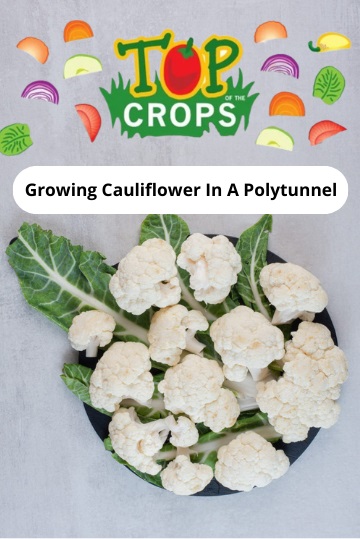Cauliflowers are a favourite in the cabbage plant family, and though they can be a little more challenging to grow successfully than other related vegetables, they can still be a good choice for polytunnel home growers.
A close relative of broccoli, bred from the same species, cauliflowers form large heads, technically called inflorescence meristems, that are usually creamy or white, but which can also come in purple, green, and a number of other hues.
To be successful in growing cauliflowers, the most important thing is to make sure that the plants are in a location where they get the growing conditions they need.
While this can be important with every crop, it can be especially important with cauliflowers which can bolt, fail to form heads or form heads that are unappetizing or only of small size if things are not quite right for their needs.
To thrive, cauliflowers need:
Full sun.
Suitable temperatures. Some cauliflowers are much hardier and can cope with lower temperatures than others. Temperatures should not rise too much in summer. Stable, mild but cool temperatures that do not fluctuate too greatly are ideal.
Deep fertile soil or growing medium with a ph between 6.5 and 7.5.
| Jan | Feb | Mar | Apr | May | Jun | Jul | Aug | Sep | Oct | Nov | Dec | |
| Sow |  |
|
 |
 |
 |
 |
 |
|||||
| Plant |  |
 |
 |
 |
 |
|||||||
| Harvest |  |
 |
 |
 |
 |
 |
 |
 |
When you are choosing which cauliflowers to grow, it is important to understand that cauliflower varieties are generally divided into categories defined by when they are ready to harvest.
There are summer varieties that are harvested in summer, sometimes these are smaller in size and suited to container cultivation.
There are also autumn varieties that are harvested before the first frosts.
And then there are winter/spring cauliflower varieties that are hardier types selected to be harvested right through the winter and into spring – especially in a polytunnel or other undercover growing area.
A good place to begin when choosing cauliflowers is with the named varieties that have received an award of garden merit from the RHS.
Once you have chosen which cauliflower or cauliflowers to grow, and have determined a suitable growing location, you will of course need to think about this crop within the wider context of your garden plans. Think about companion planting, and about crop rotation to mitigate against a number of potential problems down the line.
Cauliflowers are typically grown from seed, and when the seed is sown depends on what variety you have chosen and when its period of harvest will be.
Summer cauliflowers are usually sown in winter or early spring. Autumn cauliflowers are sown in mid-late spring, and winter/spring varieties are typically sown from late spring to early summer.
Cauliflowers may also sometimes be sown in the autumn or early winter where winter protection is available, though this will still usually only be an option for a smaller selection of varieties.
Successional sowing can help ensure a staggered harvest and avoid creating a situation where you have more cauliflower ready to harvest than you can handle all at once.
Seeds can be sown indoors, or outside either in a seed bed or directly where they are to grow. If you are sowing inside, using soil blocks or biodegradable pots is a good idea, in order to avoid root damage during transplantation.
Indoors, sow the seeds to a depth of around 1cm, covering them lightly with your seed starting potting mix, and maintain temperatures between 12 and 22 degrees C. for germination to successfully take place.
Outside, cauliflower seeds are typically sown in drills around 2cm deep, and if you are sowing them into a temporary seed bed then you should position the rows around 30cm apart. Seedlings in a temporary seed bed should be thinned to around 10cm apart once they are large enough to handle.
If you prefer not to grow from seed, plug plants or young cauliflowers are also often available to gardeners from plant nurseries or garden centres. These are planted out in the spring or early summer.
When precisely it will be best to plant depends on where you live. Remember, extremes of temperature in both directions can be a problem for cauliflower plants, so try to pay attention to the weather forecast and avoid planting out in a cold snap or a heat wave for the best chances of success.
Plant most summer cauliflowers around 45-60cm apart, though mini cauliflowers will only need a spacing of 15cm or so. Larger winter types should have a spacing of around 70cm. But this is only a rough guideline.
Cauliflower seedlings sown indoors or into a temporary seed bed will usually be ready to transplant to your garden after around 6 weeks or so. At the time of transplantation the young plants will usually be around 15cm tall.
Remember, to reduce the risk of transplantation shock and to increase your chances of success, you need to harden off your young cauliflowers before you place them into their final growing positions.
If you have sown the right varieties at the right times, and especially if you have a polytunnel, you can be harvesting cauliflowers from your garden practically all year round.
Cauliflowers planted at the same time typically mature at the same time, so harvesting some heads slightly prematurely can be a good idea to avoid a glut, or any waste.]
It is best to harvest cauliflower heads in the morning while still covered in dew – waiting until the frost has gone if it is winter.
To harvest cauliflowers, simply take a sharp, clean knife and cut off the head with a few leaves at its base.
Do not leave the heads too long – it is better to harvest small than to harvest too late as cauliflowers will quickly spoil once the heads begin to open up and flower. Do not discard fresh green outer leaves – these are also good to eat.
Cauliflowers can of course be used in a wide range of recipes. They will keep fresh in the fridge for a few days but are best used as quickly as possible, or blanched then frozen for later use. You might also use them up in a range of preserves, such as chutney or piccalilli, for example.
The main thing to think about when caring for cauliflowers in your garden is watering your crop – watering is especially crucial during the height of summer, during any dry spells, or, of course, if you are growing undercover and are responsible for providing all of the water your plants need.
Cauliflowers need consistently moist conditions, and heads won't form properly if the plants do not get the water they need. Equally, however, it is important to ensure adequate drainage and avoid overwatering, because waterlogging can also be detrimental and lead to a number of issues.
A good quality organic mulch around cauliflower plants can help conserve soil moisture. It can also provide a range of other benefits – enriching and protecting the soil, providing slow-release fertility, and suppressing weed growth to a degree.
A mulch of homemade compost or well-rotted manure can work well. But when laying it, make sure that the mulch surrounds but does not touch the stem, or rotting can occur.
Cauliflowers, like other brassicas or cabbage family plants, need plenty of nitrogen to grow well. This is why it is often recommended to grow them in rotation after nitrogen fixing peas or beans in your vegetable garden. It may also be beneficial to grow legumes alongside your cauliflower crop to maximise overall yield.
Once the cauliflower plants are established in their growing locations, but before heads form, it can also be a good idea to feed your cauliflowers with a nitrogen-rich organic liquid plant feed.
Cauliflowers, as hungry and quite thirsty plants, do not do well with too much competition, so you should keep on top of weeds. However, consider companion planting with suitable companions that will cover the ground and make the most of the space you have available without introducing too much competition.
Lettuce and other quick growing leafy greens can often work when sown between cauliflowers as a quick crop, to be harvested before the slower growing cauliflowers need the space. I also find that certain weeds, such as chickweed, can be beneficial companion plants for cauliflowers and other brassica plants.
It can sometimes be necessary to protect spring sowings or young transplants from a frost that threatens early in the spring. You can protect plants from frost by covering them with cloches or row covers of some kind.
If growing cauliflowers in winter, especially without a polytunnel, protect the heads by pulling some leaves up and over them and tying those leaves in place. You can also protect them with fleece or other reclaimed fabric layers.
Award of garden merit cauliflowers to consider for UK gardeners are:
Environmental issues are often the root causes of problems with cauliflowers such as bolting, or small or malformed heads. But even healthy cauliflowers in the perfect location can experience problems with pests. Club root is likely to occur in soils that are too acidic.
Like other brassica family plants, cauliflowers can have issues with cabbage caterpillars, birds etc. if they are not protected. It can often be a good idea, therefore, to grow them under row covers/ mesh netting to avoid any issues of this kind, as well as combatting pests through boosting biodiversity and through companion planting.
Cauliflowers can benefit from the more controlled conditions a polytunnel can provide, but it is important to make sure that temperatures do not fluctuate inside too extremely, and to make sure that it does not get too hot inside during the summer months.
When choosing how and where to incorporate cauliflowers into your garden plans, make sure you consider companion plants, and plan for successional sowing for best results. Remember to practice crop rotation and don't grow cabbage family plants in the same location over multiple years.
BBC Good Foods. 70 Cauliflower Recipes. [online] Available at: https://www.bbcgoodfood.com/recipes/collection/cauliflower-recipes [accessed 25/01/24]
